Leveraging offer flywheels to fuel unstoppable growth
How does one transform their life and their business from being $30k in debt to regularly having $90K months—while also empowering others to do the same?
For Julie Solomon, personal branding powerhouse and top influencer marketing leader, her offer suite (or offer flywheel) has been the key that unlocked ease in her multi-7-figure coaching business.
And yet, many creators and creatives will say that processes and systems stifle their creativity or complicate their lives. They say:
“I’m not good at tech”
“It takes too much time to set these systems up”
“I don’t know what to do for these funnels”
“All this stuff with offer suites freaks me out”
These are often also the same people who are burnt out from constantly selling their products and services.
What these creators don’t know is that by investing in a little bit of behind-the-scenes work to create a sales flywheel—processes and funnels can actually fuel creativity and create ease in your life and business.
That’s why we spoke to Julie—a bestselling author and a chart-topping podcast host—who’s taking all her hard-won lessons from 8+ years in business and giving you the key to a sales flywheel that’ll double (or triple) your monthly revenue.
If you’ve read our previous playbook with Ali Abdaal, you might already know about the power of offer funnels. In this article we’re taking the topic one step further to automate your offer flywheel—and help you make money while you sleep.
The goal
If you had to choose between:
A: Constantly having to show up and sell on social media, come up with new ideas of what to sell every quarter, and getting creatively and practically burnt out, or…
B: Systems that automate your sales, processes that help you come up with ideas, and funnels that keep people in your ecosystem…
Which would you pick? Seems like a no-brainer to us.
The goal of this playbook is to shift your thinking from “how do I get the next sale”, to “how can I get my offers to work together and build on another?”
How do you build a thriving sales ecosystem?
The assessment
This can be daunting, but remember: The beauty of a sales flywheel is that it comes back around. Which means you can tweak it continuously, improve upon it, and adapt it.
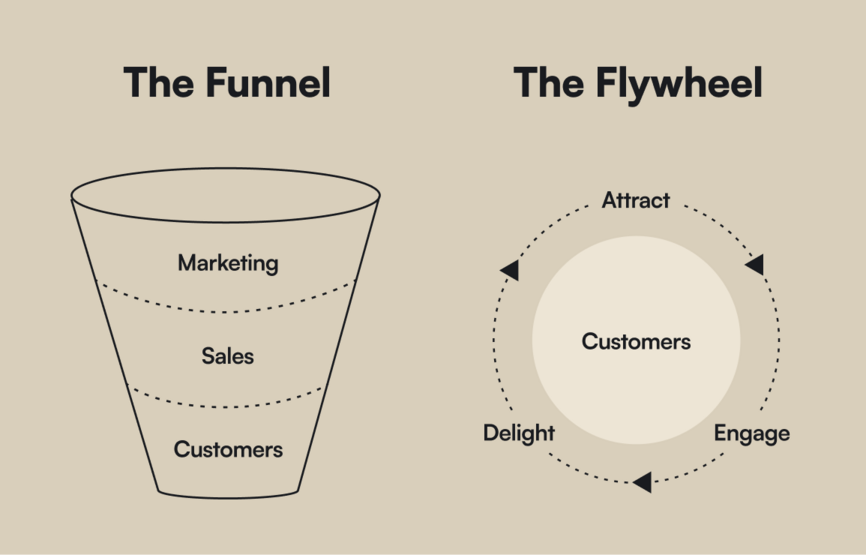
Instead of having one goal in a funnel—ie. get this person to buy this one thing and then forget they ever existed—a sales flywheel gets you to focus on solving people’s problems in a more and more helpful way (delighting them) over time, and bringing them deeper into your world.
First you bring them into your world (attract), then you provide them value for free (engage), then you solve one of their problems (delight). As you prove the transformations you can get for people and your impact, people trust you more and invest in bigger offers for more complex problems.
How can you create a flywheel with one (or several) offers? Read on.
The playbook
Julie calls your offer packaging or positioning an “offer or product suite” or ascension model, which helps you think about the way that these offers build on each other.
Lots of people won’t be ready to invest thousands of dollars with you after listening to one podcast or reading a blog—but if they’ve seen the proof of how your initial, lower offers have worked for them or others, they’ll be more likely to invest more to get bigger transformations.
Build your offers
Here’s what some of the offers in your funnel could look like.
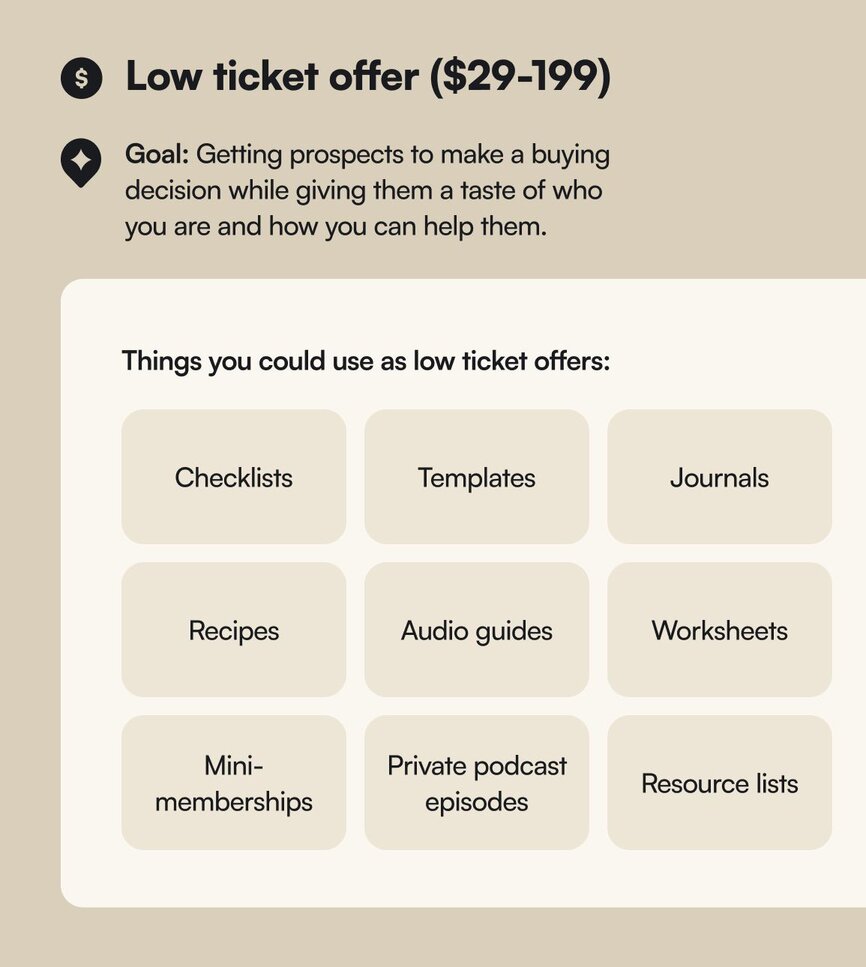
How a low ticket offer works:
- Low ticket offers are given earlier in the sales process, and are priced so your prospect barely blinks before opening their wallet.
- Does not mean low value or low-profit margins. Give prospects a lot of value up-front so they see you’re worth investing in. You wouldn’t buy a high-end face cream at Sephora if the sample they gave you was super watered down—so don’t do that to your prospects.
- Great for: Easily attracting new people into your world (via an email list or something else) while showing value, delivering quick wins, and building trust.
In practice: One of Julie’s low ticket offers called “Instantly Influence” that cost $49—brought in over $53,000 and over 4,000 new email subscribers in one year.
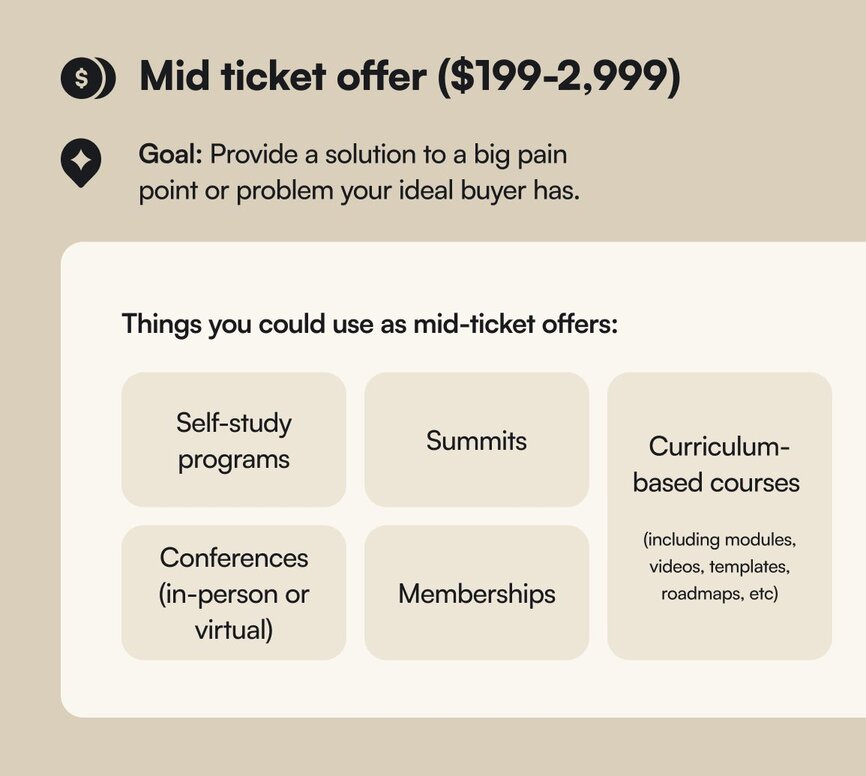
How a mid-ticket offer works:
- Mid-ticket offers solve a specific challenge or generate a desired outcome, and are priced so your prospect sees the value in investing if that particular problem is solved.
- Should not involve high levels of support, coaching, or proximity to you as the course creator—as that could cannibalize your chances of scaling a high-ticket offer.
- Great for: strong profit margins, testimonials, visibility, marketing opportunities, extending customer value. Great base for high-ticket offers like masterminds.
💡 Julie’s Tip: Self-study courses are highly profitable and highly sustainable—because it doesn’t include live components (except for launches).
In practice: For the first two years of Julie’s business, she had one mid-ticket offer at $599 and it earned her 7-figures—and supported tens of thousands of students. Their success stories then become Julie’s success stories. 🔁

How a high-ticket offer works:
- High-ticket offers are the most exclusive and premium, and are designed for people interested in achieving substantial results and transformation.
- A higher-ticket client is trying to shortcut their learning by understanding how you model things, lead your team, run your business, handle triage, and everything in between.
- Note: while one-on-one coaching is also a high-ticket offer, it’s not scalable. One-to-many is the goal to be sustainable.
- Great for: providing resilience against fluctuating economies and slower sales seasons (because you have more buffer.)
In practice: Some people are scared to charge a high-ticket offer for what it’s worth, so they sell a high ticket offer but price it like a mid-ticket one. “It’s kind of like selling a Mercedes at the price of a Kia,” says Julie.
Then, they get burned out because they’re working at such a high level but not getting the return in profit. Don’t do this! Leave the scarcity mindset behind and give yourself the dignity of creating the offer that meets people’s bigger needs.
Steal Julie’s three-pronged prospecting strategy
In order to offer something—you need someone to offer to.
How do you get those people in your orbit? You have to find and identify your ideal buyers, create a place to send them, and convert them into paying customers.
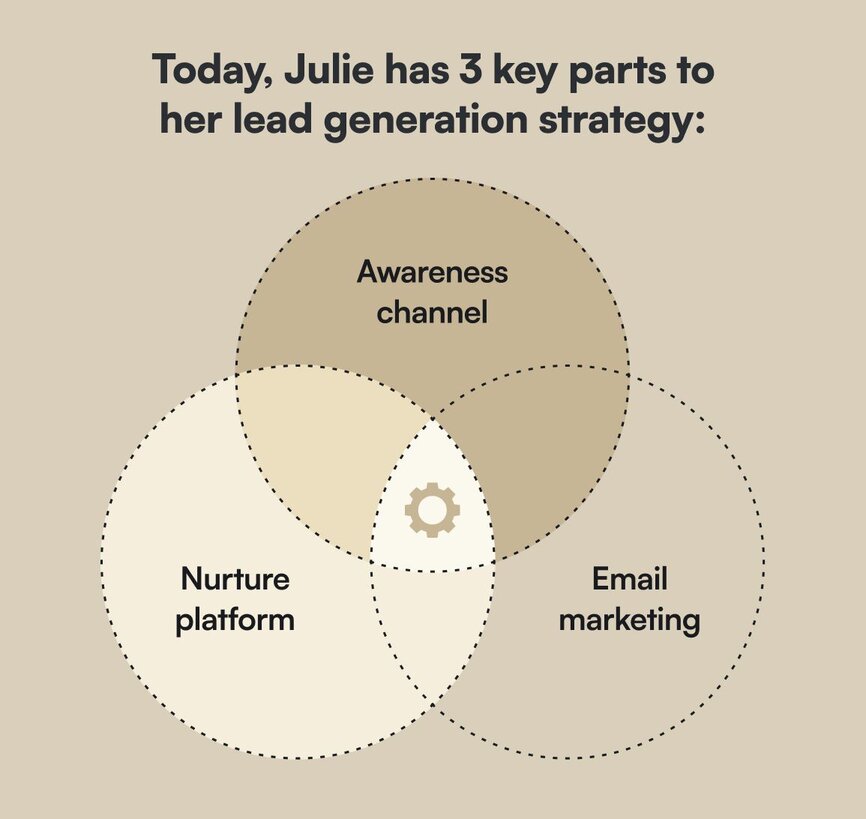
Awareness channel
An awareness channel is the strategy for how you drive awareness to your brand and business—and reach new audiences. You do this by:
- Participating in other people’s podcasts
- Speaking on stages
- Writing books
- Getting media coverage
- Securing brand deals and getting paid collabs
Julie’s example: Julie heavily focused on brand collaborations, guest posting, media appearances and virtual events when she first started in 2016. Those brand collaborations helped her grow her visibility from 0-2,200 email subscribers a year later—without a robust strategy.
Watch Julie's Free Masterclass Here:
3 Steps to Grow Your Following and Land $10K Brand Deals in Just 30 Days
Nurture platform
A nurture platform should be used to create the evergreen content library that stays valuable for years to come—and slowly strengthens your relationship with your audience. This is the key to visibility and authority in your space. It could include:
- YouTube videos
- Podcast
- A blog
- Social (although it’s become more of a short-form content consumption platform than a nurturing one)
Julie’s example: It takes Julie about 10 hours per month to record weekly episodes for The Influencer podcast, but it is the #1 lead gen driver for her company. Plus, she has 7+ years of evergreen content that she can repurpose into articles, courses, freebies, and more.
Email marketing
Over 80% of your sales will come from email. It’s the place where you will connect with and nurture your warmest leads, and for most creators? Your most engaged platform.
Plus? It’s an “owned” channel—a list of people you can contact and sell to that isn’t a social media account that could be shut down at any time.
Turning it all into a sales flywheel
This is how Julie gets people into her world and converts them into fans:

Combine these two things to generate a predictable sales flywheel
What’s the secret to Julie’s sales? A one-two punch of evergreen funnels, and live launches.
Evergreen funnels: means having something to sell all the time on autopilot. These are the invisible sales systems that work behind the scenes that allow people to buy on their timeline.
Live launches: means a promotion that opens and closes on certain dates. You show up and promote it on your timeline. Not only do you increase your visibility at that moment, but you also get real time feedback, and generate significant revenue quickly.
Live launching a few times a year is a great cadence because different buyer behaviors exist. Some know immediately; others take months to decide.
Foundational pieces for invisible sales systems
The beauty of the things that you need to build for both live promotions and evergreen funnels is that once they’re created, you can tweak them for years to come.
“I don’t believe in starting from scratch. I still use emails I wrote 5 years ago. I believe in making everything I create—whether an instagram live or email—work so hard for me,” says Julie.
This is what you need as a baseline:
- Landing page: Where a visitor arrives after clicking a call to action.
- Example: Opt in pages, webinar registration pages, application pages, replay pages, thank you pages, sales pages
- Training: Where you present something of high value.
- Ex: webinar, workshop, training, bootcamp, masterclass, challenge, video series, etc
- Email sequence: A series of emails for those who registered on your landing page for your training. Should contain stories, key messages, and a link to purchase in every email.
Sales funnel: series of strategic relationship-building experiences that turn prospects into buyers through an automated process.
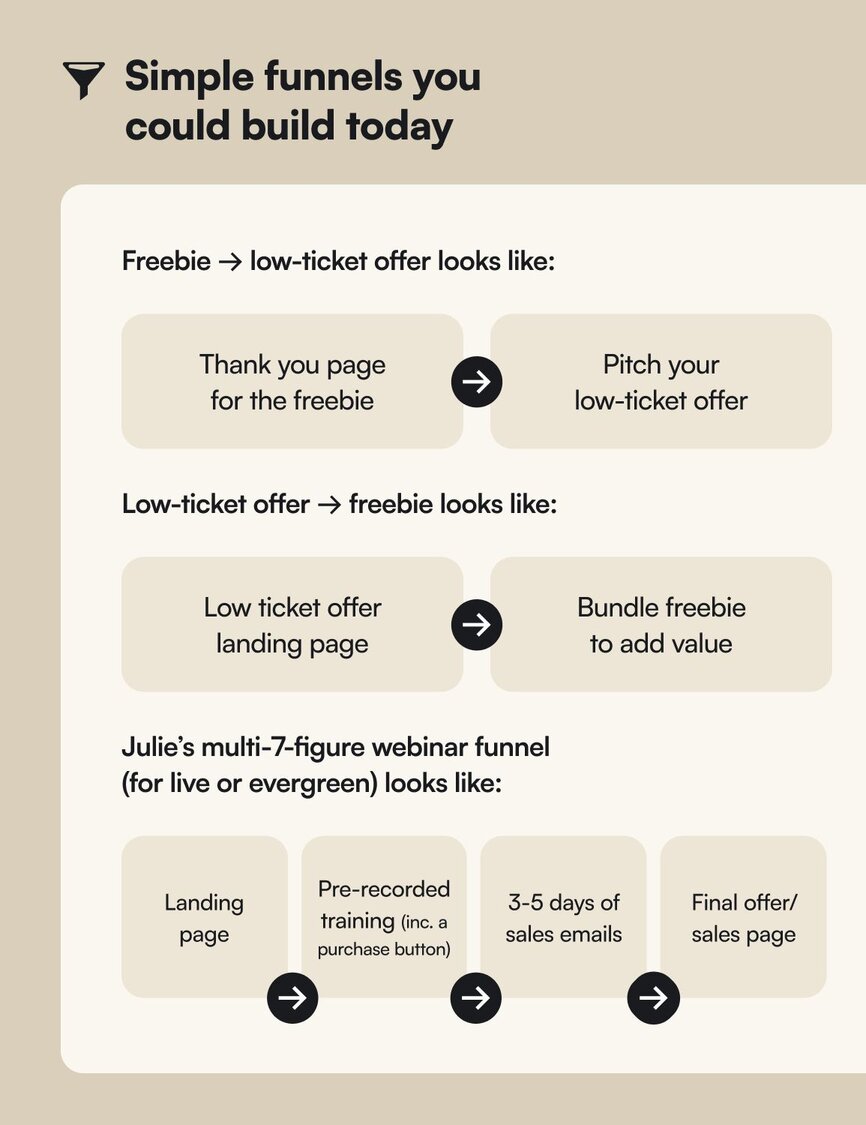
The results
Julie grew up with her family living paycheck to paycheck—and has transformed her life, her finances, and her mindset with her business so that she can empower others the way she empowered herself.
Her experimentation has transformed her from being constantly in-debt to a millionaire, a top podcast host (10M downloads and counting), and a true influencer and coach.
But her biggest claim to fame is the results she gets for her clients.
Berkley Sweetapple—an attorney for online businesses and law firm owner—had her highest earning month ever ($51,000) within 30 days of applying Julie’s strategies to her business.
Steph Weber, founder of The Weber Co Marketing Agency, had a $40,000 cash month after working with Julie and implementing some invisible sales systems.
Want to get these sort of results? Fill out this form to work with Julie.
Julie’s learnings:
- You don’t need every offer built out to find success. Julie certainly didn’t get there overnight or have all of her offers figured out from day one. So if you’re earlier on in your creator journey, remember: don’t compare someone’s success to your own, because it’s likely that it took them a while to get to where they are today.
Plus, you can build a 6-7 figure business on just one offer. Julie hit 7 figures with her mid-ticket offer ($599) in the first two years of her business. - You only see the tip of the iceberg at the start, which means you can’t reverse engineer a successful funnel from the get-go. A successful funnel requires the right strategy, processes, and systems—as well as the in-between things like messaging, what to say in the emails, the triggers, automations, email sequences etc. You need the whole recipe before you can try to recreate it—not just the final outcome.
- Always consider the lifetime value of your buyer. Because the more sophisticated the market gets, the more you should consider adding different offers for different people based on their level of sophistication. How will you extend the lifetime value of your buyer? How will you continue to get them to want to work with you?
- You need both evergreen and live launches. “People ask: Is evergreen or live launching better? But that question is a waste of time. You need to figure out how to do both well, because not everyone will buy from your evergreen offers, and not everyone will buy from your launches,” says Julie.
Key takeaways
- Give the people what they need. Some people are only aware of their small needs and problems, while others have been struggling with big blockers that they’d pay a lot of money to make go away—immediately. Make sure you build in optionality in your funnel and your offers.
- Your business doesn’t have to be hard or difficult to grow. Systems, processes, playbooks, recipes—whatever you want to call them—can help you build automation into your business that doesn’t have you starting from scratch every quarter or micromanaging every tiny detail and getting overwhelmed.
- Don’t reinvent the wheel—but start building the system. “I'm a firm believer in not reinventing the wheel because it's not about what you have already heard or who you've heard it by, or even what you already know. It's about how you are using what you know,” says Julie. “Because ultimately, the number of offers doesn’t matter as long as they’re feeding the greater ecosystem and talking to each other in a succinct and complementary way to ensure the sustainability of your business,” says Julie.
And if you’re a creator looking for an all-in-one community platform?
You’re in the right place.
Circle brings together your members, discussions, events, courses, and content—all in one place, under your own brand. Plus, you get access to our customer community full of handy resources and over 10,000 community builders on the same journey as you.